Through the Heart of (Old) Europe
Belgium, July 6-8, and Luxembourg, July 9-10
On Thursday we drove directly from the northern Netherlands to Brussels, where Todd had a meeting late that afternoon with Ambassador Adriaan Jacobovits, the European Union’s Special Representative for the Transnistrian problem in Moldova. Our Hotel Noga was only a few minutes’ walk from the Grand Place in a surprisingly quiet street in a restaurant-rich neighborhood, where we ate every night. The hotel’s most memorable features were its décor, with faded pictures of the Belgian royal family from 1830 on, and a private garage for Valeriu for the incredible sum of 10 euros a night. (Cf. Amsterdam, where we spent 36 euros to park for nine hours in a municipal garage.)
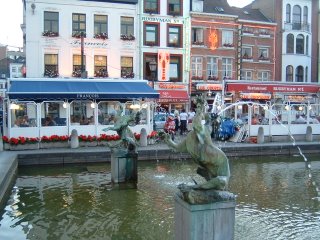
Rue du Commerce near our hotel in Brussels
While Todd went to his meeting, Georgia visited the Grand Place and, of course, the Manneken Pis. We later observed to our bemusement that while a small boy urinating is placed on a pedestal, the dogs of Brussels are accorded a measure of privacy when relieving themselves.

Grand Place, Brussels

Manneken Pis
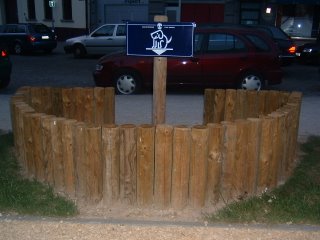
Canine pissoir, Brussels
On Friday Todd had more Moldova-related meetings, kindly organized by Viorel Ursu of the Open Society Institute, so Georgia took the train for a day in Bruges. She had a charming introduction to the city by taking a boat trip along the city’s canals and then wound her way through the historic center, finding yet another Begijnhof where today there are Benedictine nuns rather than lay sisters. Bruges’s premier museum, the Groeninge, provided a wonderful array of early Flemish and Dutch masters, and the Basilica of the Holy Blood was a treat not to be missed--highly decorated and home to one of the most sacred relics in Europe (they even have a “sentry” guarding it at all times). The highlight, however, was Michelangelo’s “Madonna and Child” at the Church of Our Lady--one of the few Michelangelo sculptures outside of Italy.
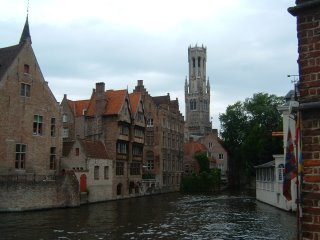
The Belfort, Bruges
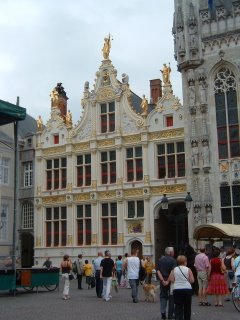
Old Recorder's House, Bruges

Band concert in Markt, Bruges

Michelangelo's Madonna and Child
Saturday was devoted to shopping and sightseeing in Brussels. Georgia got a running start on the Avenue Louise while Todd put the finishing touches on his written testimony in the Valeriu Pasat case (see our blog posting of April 17, "Arrived in Europe!"). When her spirits began to flag, Todd came to the rescue and we soldiered on through more boutiques until Georgia found the perfect jacket to wear to the Stuttgart opera. Then we walked on to the center of town for total immersion in Brueghel, Rubens and other Flemish masters at the Musees Royaux des Beaux-Arts before visiting the Parc du Cinquantenaire near the EU headquarters and finally heading home by subway.

Palais Royal, Brussels

Parc du Cinquantenaire, Brussels

We were tempted, but . .
Todd had toured the Duke of Wellington’s mansion in London so it seemed reasonable to stop at Waterloo, the field that sealed his fame, on our way out of Brussels on Sunday. The lion monument is well commercialized, but we visited several touching cenotaphs, especially one memorializing Wellington’s aide de camp, killed in the battle, whose Scottish family described this young lieutenant colonel in most affectionate terms.
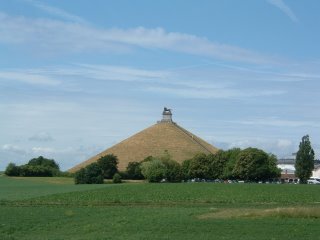
Waterloo
In mid-afternoon we crossed into Luxembourg. We had made reservations at the Hotel Gruber in Steinheim, a village outside the town of Echternach, both of which are located on a beautiful river that forms the border with Germany. All of these names sound very Germanic, but as we discovered, language in Luxembourg is not a simple matter. The official tongue is French, but the guidebooks say that German is widely used for social interaction. Yet, as we soon discovered, Luxemburgerisch, a German-based dialect, is at least an equal partner in the country’s linguistic triumvirate. Commercial signs appear in one or another of the three languages, and on the bulletin board of our village we saw official notices in all three.
Our stay in Luxembourg could not have been more pleasant. We rode bikes along the river to visit Echternach’s abbey, which had housed a scriptorium founded in the 8th Century by a missionary from Northumbria who taught his newly recruited monks how to copy holy texts. The next day we drove into Luxembourg City, a capital in miniature, where we watched respectfully as the Grand Duchess was driven off from the Palace. After an excellent dinner at our hotel, we strolled across a footbridge into Germany, reflecting on how closed this border was in the late 1930’s and how much destruction was wrought here in 1945, when the Echternach basilica was badly damaged as the retreating Germans defended the border against Patton’s advancing army.

Echternach
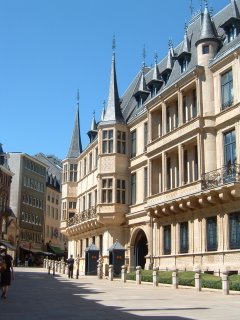
Palais Grand Ducal, Luxembourg City

0 Comments:
Post a Comment
<< Home